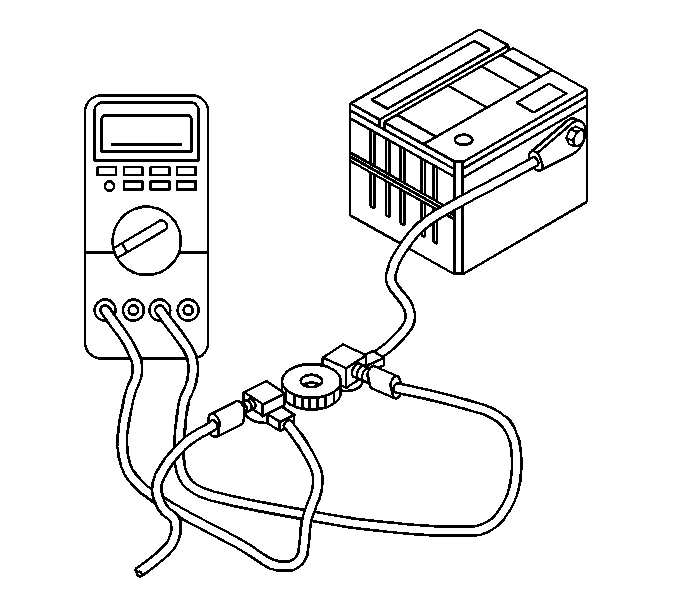Tools Required
| • | J 38758 Parasitic Draw Test
Switch |
Notice: Do not turn the parasitic draw test switch to the OFF position with
the engine running. Damage will occur to the vehicle's electrical system.
Notice: The test switch must be in the ON position when removing the fuses in
order to maintain continuity in the electrical system. This avoids damaging
the digital multimeter due to accidental overloading, such as
a door being opened to change a fuse.
- Disconnect the negative battery cable. Refer to
Caution: Unless directed otherwise, the ignition and start switch must be in the OFF or LOCK position, and all electrical loads must be OFF before servicing
any electrical component. Disconnect the negative battery cable to prevent an electrical spark should a tool or equipment come in contact with an exposed electrical terminal. Failure to follow these precautions may result in personal injury and/or damage to
the vehicle or its components.
in General Information.

- Install the male end of the J 38758
to the negative battery terminal.
- Turn OFF the test switch.
- Install the negative battery cable to the female end of the test
switch.
- Turn ON the test switch.
- Road test the vehicle while activating all accessories, including
the radio and the air conditioning.
- Turn OFF the ignition switch. Remove the key.
Important: From this point on, electrical continuity must be maintained in the
ground circuit of the battery through the J 38758
in the ON position or through the J 39200
.
- Components such as the PCM have timers that draw several
amps of current while they cycle down. This can give a false parasitic drain
reading. Wait 15 minutes for these components to power down before continuing
this test.
- Connect a jumper wire with a 10 A fuse J 36169-A
to the terminals of the Test switch.
- Turn the test switch to the OFF position.
- Wait ten seconds.
If the fuse does not blow, the current is less than 10 A.
The multimeter can be used safely.
- Before the fused jumper wire is removed, turn the test switch
to the ON position.
- You can detect a high current drain using the following procedure:
Important: If an ammeter other than the J 39200
is
used, ensure that the vehicle does not have a high current drain that would
damage the multimeter when connected to the circuit.
- Set the J 39200
to the 10 A
scale.
- Connect the ammeter to the test switch terminals.
- Turn OFF the test switch. This allows the current to flow through
the multimeter.
- Wait one minute, then check the current reading.
| • | When there is a current reading of 2 A or less, turn ON
the test switch, this maintains continuity in the electrical system. |
| • | Then, switch the meter down to the 2 A scale, for a more
accurate reading, when the test switch is reopened. |
- Take the reading in milliamps.
- Note the battery reserve capacity. Refer to Battery Usage Table.
| • | Divide this number by 4. |
| • | Compare this to the multimeter reading. |
| • | The current drain should not exceed this number. |
| • | Example: if a battery has a reserve capacity of 100 minutes, the
current drain should not exceed 25 milliamps. |
- When the current draw is too high, remove the electrical system
fuses one at a time until the draw returns to a value less than or equal to
specifications.
| • | Start with the fuses that are hot all the time. |
| • | To remove the fuse, you must first open the door, which causes
a high enough current flow to damage the multimeter. |
| • | Protect the multimeter, without disturbing the electrical continuity,
by turning ON the test tool before opening the door. |
| • | Remove the courtesy lamp fuse. |
| • | Note the multimeter reading. |
| • | If the parasitic load is still excessive start removing the remaining
fuses one at a time. |
| • | Keep the courtesy lamp fuse out during diagnosis, so the door
can remain open. |
- Repeat the parasitic current drain test procedure after any repair
has been completed.
- When the cause of the excessive current draw has been located
and repaired, remove the multimeter and the parasitic draw test switch.
- Connect the negative cable to the negative battery terminal.
Tighten
Tighten the battery cable attaching bolt to 15 N·m (11 lb ft).
Notice: Use the correct fastener in the correct location. Replacement fasteners
must be the correct part number for that application. Fasteners requiring
replacement or fasteners requiring the use of thread locking compound or sealant
are identified in the service procedure. Do not use paints, lubricants, or
corrosion inhibitors on fasteners or fastener joint surfaces unless specified.
These coatings affect fastener torque and joint clamping force and may damage
the fastener. Use the correct tightening sequence and specifications when
installing fasteners in order to avoid damage to parts and systems.

